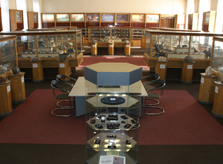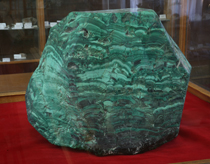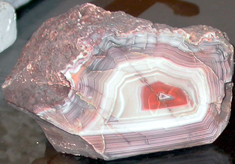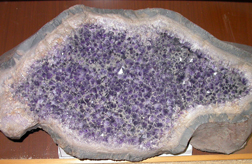|
|
Museum of Geology and Mineralogy
Just geologica (mineralogical) museums can acquaint with enchanting world of the natural stone, great variety of minerals, rocks, ores, paleontology occurences, and teach to appreciate and preserve the Nature. The museum of geology and mineralogy of the National Mining University (NMU) is one of the largest and most substantial museums of such a type. The museum has functioned since the beginning of the last century first as the part of mineralogy room, and since August 19, 1935 as an independent subdivision of Dnipropetrovsk Mining Institute (DMI). There was hardly anything left of the museum in the period of the Great Patriotic War. Pre-war collection contained about 20,000 exhibits. Only 10 samples of them were managed to save. Revival of the museum, or rather a new museum creation have been lasted for eleven post-war years. Only in 1955 first visitors were greeted. The exposition contains about 3,000 exhibits, its area is over 350sq.m, there are 44 glass cases and 45 separate rests for samples in it. There are three main trands in it: Mineralogy, Crystallography, Petrography; Historical Mineralogy and Paleontology; Useful Minerals. The section of Mineralogy, Crystallography The section if Historical Geology and Paleontology has been formed according to the principles of geological time-scale. Various forms of organisms of flora and fauna have ever existed, the imprints of their lives in the form of fossils, cardinal forms of organisms in accordance with the stages of geological evolution of the Earth and taxonomical classification of biogenic world. Petrified remnants of dinosaur�s limbs from Mongolia, imprints and internal casts of the ammonite and large-size bivalve mollusks, bones of mammals of Quaternary period; petrified tree trunks of the Carboniferous and Paleogene periods. Genetical classification of metalliferrous and non-metalliferrous raw materials and their use by the National Economy are the basis of Useful Minerals Section. The ores of black and colour metals, raw materials for building, chemical, glass and ceramics industries, mineral pigments, fire-and acid-proof materials, fluxes and other mineral raw materials from different world deposits are represented here.
Dense, zoned-concentric sintered malachite is a very valuable for its being a decorative stone. In 1922 a group of Geology students headed by M.A. Torgud brought the sample of malachite weighing 31 poods (over 500kg) from Midnorudnyanske deposit. . The quick wit of the Institute employees saved it during the war by means of painting thanks to which the Nazi knew nothing of it uniqueness. But after the fire in the main building of DMI had been initiated by fascists in 1943, the malachite block was burnt heavily on the edges. Only its core came off safe and sound, and it had been restored and grinded after the war. Thanks to articles made of such jewellery malachite the Urals masters have been glorified all over the world. �nd such masterpieces as the Malachite Hall in Hermitage or malachite pillars of the Isaac Cathedral in St. Petersburg are known in many countries. It�s a great pity that all known malachite deposits in the Urals have been depleted, and you can see such samples only in museums.
Up to 5,000 students, pupils, representatives of enterprises, participants of different conferences, seminars and symposia visit the museum annually. The exhibition is highly appreciated by famous political figures, scientists, cultural workers of Ukraine and world and the general public. The museum is an educational laboratory where students are taught Geology and post-graduates make their research. Its vocational and educational activities favour the interest increase in geological specialities, display harmonic perfection of the Nature, inspire to create and enjoy the results of creative work. Photos of museum exhibits you can review in the Gallery. Contactscontact tel.: (0562) 45-85-03 Museum works: Monday to Thursday 900 � 1700 Friday 900 � 1500 |


 Since
ancient times people have been interested in the stone. Tools,
arms, the dishes, amulets had been made of it. Later stone had been used to
build houses, manufacture paints, melt metals... But
the interest of the mankind in the stone was not only utilitarian. People highly appreciate magnificent beauty of some varieties of the
stone and use them to make jewelry.
Since
ancient times people have been interested in the stone. Tools,
arms, the dishes, amulets had been made of it. Later stone had been used to
build houses, manufacture paints, melt metals... But
the interest of the mankind in the stone was not only utilitarian. People highly appreciate magnificent beauty of some varieties of the
stone and use them to make jewelry. and Petrography is based upon the grounds of chemical
classification of minerals (after �.G. Betekhtin). Separately minerals
according to their physical properties (gravity, hardness, colour and shade,
glance, transparency, cleat, streak colour, etc.), morphological properties,
and mineral aggregates, magmatic, metamorphic and sedimentary rocks are
displayed. You can see the fragment of beryl crystal from Volyn pegmatite which
weight is 7,75kg and dimensions are 18x14cm; ametyst geode from Brasil; growth
of antimonite crystals which lenght is about 35cm and weight-over 8kg from
Japan. Since 1917 the latter has been in the museum being the oldest its
exhibit.
and Petrography is based upon the grounds of chemical
classification of minerals (after �.G. Betekhtin). Separately minerals
according to their physical properties (gravity, hardness, colour and shade,
glance, transparency, cleat, streak colour, etc.), morphological properties,
and mineral aggregates, magmatic, metamorphic and sedimentary rocks are
displayed. You can see the fragment of beryl crystal from Volyn pegmatite which
weight is 7,75kg and dimensions are 18x14cm; ametyst geode from Brasil; growth
of antimonite crystals which lenght is about 35cm and weight-over 8kg from
Japan. Since 1917 the latter has been in the museum being the oldest its
exhibit.  Besides, the organic useful rocks, facies, devices to
study minerals, rocks and ores, samples of gem-stone raw materials, precious
and semi-precious stones (for example, amber, topaz, beryl), articles made of
them, blue grounds from a number of Yakut-Sakha diamond pipes, the collection
of meteorites are exhibited in separate glass cases. CASTLE souvenir made of
pagodite and gagate is one of the most beautiful exhibits of the museum. It�s a gift by Chinese students (DMI
graduates, 1961).
Besides, the organic useful rocks, facies, devices to
study minerals, rocks and ores, samples of gem-stone raw materials, precious
and semi-precious stones (for example, amber, topaz, beryl), articles made of
them, blue grounds from a number of Yakut-Sakha diamond pipes, the collection
of meteorites are exhibited in separate glass cases. CASTLE souvenir made of
pagodite and gagate is one of the most beautiful exhibits of the museum. It�s a gift by Chinese students (DMI
graduates, 1961). There are about 19,500 samples in the
collection of the museum from Ukraine and many foreign countries.
There are about 19,500 samples in the
collection of the museum from Ukraine and many foreign countries.